Table of Contents
- From Load to Fold: Simplifying the Laundry Journey
- The Basics: What is an Automatic Washing Machine?
- The History: A Glimpse into the Past
- Features & Functions: What Can It Do?
- Benefits: Why Filipinos Love Their Automatic Washing Machine
- Caring for Your Machine: A Few Tips
- The Automatic Washing Machine: An Essential During the Rainy Season
- Discovering the World of Washing Machines
- Manual vs. Automatic Washing Machines: Which Suits Your Laundry Lifestyle?
- Maintenance and Longevity: Manual vs. Automatic Washing Machines
- Impact on Fabric Quality: Understanding the Dance Between Fabrics and Machines
- Safety and Precautions in Washing Machines: A Comparative Analysis
- In Summary: The Modern Marvel of Laundry
- Key Takeaways:
- Frequently Asked Questions About Automatic Washing Machines
From Load to Fold: Simplifying the Laundry Journey
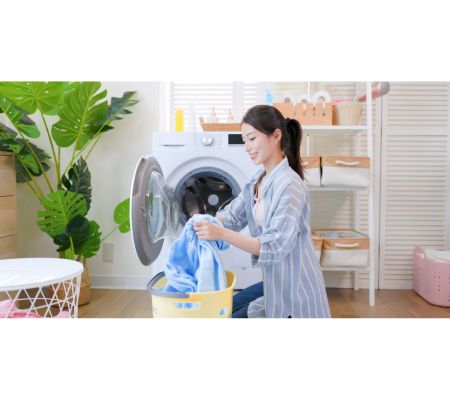
In a bustling Filipino household, where busy work schedules meet family time, every minute counts. Enter the automatic washing machine, a real time-saver and a modern day marvel.
Here’s a peek into how this machine has changed the Filipino way of life and why it deserves a spot in every home.
The Basics: What is an Automatic Washing Machine?
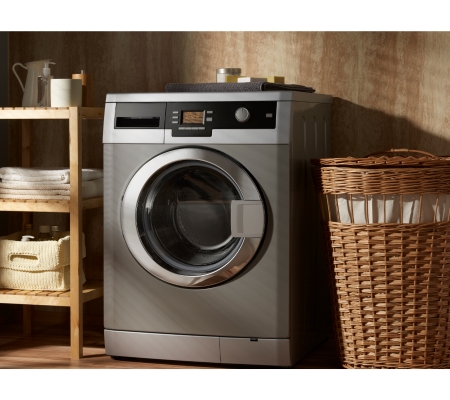
At its core, an automatic washing machine is an electrical appliance designed to wash and sometimes dry your clothes, with little to no manual intervention.
You pop in your dirty laundry, add some detergent, press a few buttons, and let the machine do its magic.
The History: A Glimpse into the Past
While washing machines have been around for over a century, it wasn’t until the late 20th century that they became more accessible to the average Filipino household.
Before these automated wonders, Filipinos would hand wash their clothes, a laborious process involving scrubbing each item over washboards or beating them on rocks, typically by riversides.
Today, while some still prefer the traditional ‘labada’ method, many have embraced the convenience of automatic washing machines. The transition isn’t just about ease; it’s about optimizing time for more valuable moments, like spending it with family.
Features & Functions: What Can It Do?

- Various Wash Cycles: Depending on the model, automatic washing machines can have multiple settings, catering to different fabric types – from delicates to heavy-duty jeans. Some even have special modes for baby clothes or heavily soiled items.
- Spin & Dry: After washing, the machine spins your clothes at high speeds to extract excess water, reducing drying time. Some models also come with a built-in dryer.
- Delay Start & Timer: Planning to be out and about? No problem! Set the machine to start washing at a later time and come home to fresh laundry.
- Water Level Options: Many machines allow you to adjust the water level based on the laundry load, ensuring efficient water use – a crucial feature given the water shortages in some Philippine areas.
Benefits: Why Filipinos Love Their Automatic Washing Machine
- Time-Saving: Say goodbye to dedicating hours for laundry. With an automatic washing machine, you’re free to multitask. Maybe cook that adobo you’ve been craving, or catch up on your favorite teleserye.
- Consistent Results: Uniform washing every time! No more worrying about under-washing or over-scrubbing. Your clothes come out clean and intact.
- Economic: While there’s an upfront cost to purchase, think of the long-term savings. Less water use, reduced electricity bills (especially with energy-efficient models), and longer-lasting clothes.
- Health Benefits: In the tropical climate of the Philippines, clothes can easily attract mold and bacteria if not washed and dried properly. Automatic washing machines ensure thorough cleaning and faster drying, promoting a healthier lifestyle.
Caring for Your Machine: A Few Tips
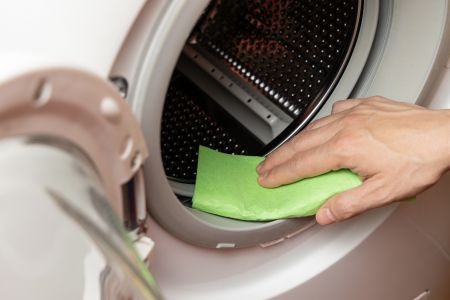
For your washing machine to serve you well, it needs a bit of TLC:
- Regular Cleaning: Ensure you clean your machine regularly to prevent mold and detergent buildup. It’s good practice to leave the door open after every wash to allow it to air out.
- Use the Right Detergent: Always use the recommended type and amount of detergent. Too much can lead to residue, while too little won’t clean effectively.
- Avoid Overloading: Respect the machine’s load limit. Overloading can reduce washing efficiency and potentially damage the machine.
- Check Pockets: Before tossing clothes in, check the pockets. Coins, pens, or other items can damage the drum or cause unwanted stains.
An automatic washing machine isn’t just an appliance; it’s a partner in the daily rhythm of Filipino life.
Whether it’s a busy mom balancing work and kids, a student hustling between classes, or a professional with back-to-back meetings, this machine ensures that laundry doesn’t become an added burden.
With this in mind, it’s easy to see why the automatic washing machine is quickly becoming a staple in Filipino households.
It’s more than just convenience; it’s a testament to how Filipinos value time, efficiency, and the simple joys in life.
The Automatic Washing Machine: An Essential During the Rainy Season
The Philippines, blessed with its tropical climate, has a distinct rainy season which can last from June to November. This period of regular downpours and occasional typhoons brings with it a unique set of challenges, especially when it comes to laundry. Here’s why the automatic washing machine is not just a luxury, but an essential appliance during these wet months.
1. Faster Drying Times
- Efficient Spinning: One of the biggest challenges during the rainy season is getting clothes to dry. The high-speed spin cycle in automatic washing machines effectively removes a significant amount of water, reducing drying time. Even when the sun is playing hide-and-seek, clothes are closer to being dry right out of the machine.
- Built-in Dryers: Some models come equipped with built-in dryers. These are lifesavers during continuous rainy days when outdoor drying is nearly impossible. The clothes come out ready to wear or require minimal indoor air drying.
2. Health and Hygiene
- Mold Prevention: Damp clothes, if left unattended, can quickly become breeding grounds for mold and bacteria, especially in the humid Philippine climate. An automatic washing machine ensures that clothes are thoroughly cleaned and spun dry, minimizing the risk of mold growth.
- Allergen Removal: Rain can stir up pollen and other allergens. Modern washing machines often have allergen-removal cycles or high-temperature washes that ensure allergens are effectively eliminated from your clothes, keeping you and your family healthy.
3. Space Saving
- Indoor Drying: With limited sunshine, many Filipinos resort to indoor drying during the rainy season. This can clutter the house, making spaces feel cramped. However, since clothes from the automatic washing machine are well spun, they take up less drying space, reducing indoor clutter.
- No Need for Manual Washing Setup: An automatic washing machine negates the need for large basins, scrubbing brushes, and other manual washing tools, freeing up space at home.
4. Consistent Cleaning Despite Weather Challenges
- Predictable Results: Rain or shine, an automatic washing machine delivers consistent results. You don’t have to worry about rushing your laundry because of an impending downpour or not being able to scrub enough due to gloomy weather affecting your mood. The machine ensures that your clothes are clean every single time.
- Adaptable Settings: Whether you’ve been drenched in a sudden downpour or you need to freshen up slightly damp clothes, modern machines have various settings to cater to these specific needs.
5. Energy and Water Efficiency
- Optimized Water Usage: During the rainy season, certain regions might face water shortages due to disruptions or contamination. Automatic washing machines, especially newer models, are designed to optimize water use. They adjust the water level based on the laundry load, ensuring that not a drop is wasted.
- Economical Operation: Many modern washing machines come with energy-efficient features. Even if used more frequently during the rainy season, they don’t significantly hike up the electricity bill.
The rainy season in the Philippines presents a myriad of laundry challenges, from prolonged drying times to potential health concerns.
The automatic washing machine addresses these issues, proving its worth and indispensability during these wet months.
Whether for health, convenience, or efficiency, it’s clear that this appliance is a rainy season game-changer for Filipino households.
Discovering the World of Washing Machines
Alright, so you’ve decided to step up your laundry game and invest in a washing machine. But wait a minute! There’s more than just one type. Dive in with us as we journey through the fascinating world of washing machines and break down their diverse types.
1. Top-Load Machines
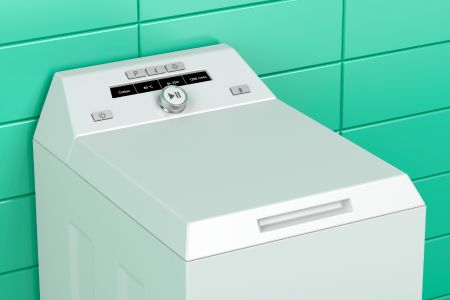
- How They Work: Just like the name suggests, these machines have a lid on the top. You drop in your laundry, close the lid, and let it do its thing.
- Advantages: They are often more affordable and can be filled with water manually, which is useful in places with irregular water supply. Plus, you can often add clothes mid-cycle, just in case you forgot a sock or two.
- Drawbacks: They might consume a tad more water than front-loaders and can be a bit rougher on clothes because of the agitator mechanism.
2. Front-Load Machines
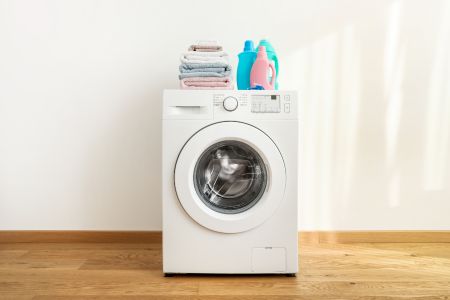
- How They Work: Think of a mini laundromat in your home. These machines have a door at the front. You load your clothes horizontally, and they tumble inside to get clean.
- Advantages: They’re champions at water and energy conservation. Because of their tumbling action, clothes get washed more gently, resulting in less wear and tear. They also often have a larger capacity, which means fewer loads.
- Drawbacks: They can be pricier upfront and require a bit of bending to load and unload, which might not be ideal for everyone.
3. Semi-Automatic Machines
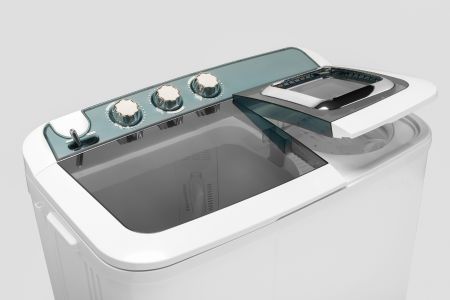
- How They Work: Imagine a machine that’s a blend of manual and automatic. Semi-automatic machines have separate tubs for washing and spinning. After the wash cycle, you manually transfer clothes to the spin tub.
- Advantages: They give you more control over the wash process and often come at a more affordable price point. They also allow you to save water by using the same water for multiple wash cycles.
- Drawbacks: The manual intervention of moving clothes from one tub to the other might not be everyone’s cup of tea.
4. Fully Automatic Machines
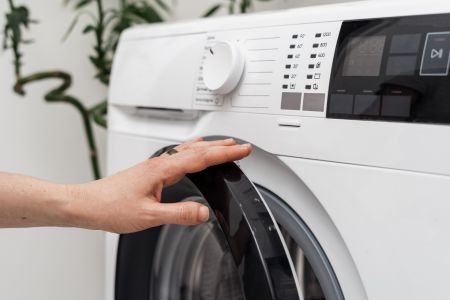
- How They Work: Put your clothes in, press a button, and relax! These machines handle everything from washing to spinning in the same tub.
- Advantages: The convenience factor is off the charts. They save time, reduce manual effort, and come with a myriad of features and wash programs.
- Drawbacks: They usually come with a heftier price tag and might consume more water than their semi-automatic counterparts.
5. Compact or Portable Washers

- How They Work: These are like the little siblings in the washing machine family. Compact, often on wheels, and perfect for small spaces or for those on the move.
- Advantages: Ideal for apartments, dorm rooms, or for those who move frequently. They fit snugly in small spaces and are often more budget-friendly.
- Drawbacks: They have a smaller capacity, which means more frequent washes. They might also lack some of the fancier features of bigger machines.
6. Washer-Dryer Combos
- How They Work: Wash and dry all in one go! These machines not only clean your clothes but also dry them in the same cycle.
- Advantages: They save space and are perfect for those without a place to hang dry clothes. Great for rainy seasons or small apartments.
- Drawbacks: The drying cycle can be relatively long. Also, if the machine breaks, you’re out of both a washer and a dryer.
Embarking on the washing machine journey is more than just choosing an appliance; it’s about finding the right partner for your laundry needs.
Whether you value convenience, budget-friendliness, or eco-efficiency, there’s a washing machine out there just waiting to make your life a whole lot easier.
Manual vs. Automatic Washing Machines: Which Suits Your Laundry Lifestyle?
Ah, the great laundry debate: Manual or Automatic? Before you dive headfirst into the world of washing machines, it’s crucial to understand the nitty-gritty of both types. Let’s unravel the strengths and weaknesses of each, so you can find your laundry match!
The Manual Machine Experience
1. Definition: A manual washing machine, sometimes known as a semi-automatic machine, typically comes with separate tubs for washing and spinning. After the wash cycle, you’re the one flexing those muscles to transfer the clothes for spinning.
2. Advantages:
- Flexibility: Easily pause between wash and spin cycles. Spotted a stain that needs a little extra attention? No problem! Scrub away without a whole machine cycle holding you back.
- Water-Efficient: You can reuse the water from one wash cycle for another batch of clothes. A huge perk in areas facing water scarcity.
- Budget-Friendly: Manual machines tend to be easier on the pocket, making them a favorite among many budget-conscious households.
- Quick Wash Cycle: Need your favorite shirt in a jiffy? Manual machines can wrap up a cycle faster than some automatic machines.
3. Ideal For:
- People on a Budget: If you’re watching your pennies, manual machines offer solid value for money.
- Those Seeking Control: Love having a say in every stage of the wash? This is for you!
- Areas with Limited Water: You dictate the water usage, ensuring not a drop is wasted.
The Automatic Machine Adventure
1. Definition: A fully automatic washing machine takes you from dirty laundry to fresh clothes without any manual intervention. You toss in the clothes, press a few buttons, and let the machine handle the rest.
2. Advantages:
- Supreme Convenience: No need to babysit this machine. Load it, set it, and forget it until it’s time to unload.
- Advanced Features: Many models come packed with features like delay starts, custom cycles, and more. Some even have built-in heaters for a warm wash.
- Gentle on Clothes: The tumbling action, especially in front-load machines, can be much gentler on clothes than the agitator method in manual machines.
- Space Savers: With just one tub, they often have a smaller footprint, perfect for tighter spaces.
- Energy and Water Efficiency: Modern automatic machines often come with sensors to adjust the water and energy consumption based on the load.
3. Ideal For:
- Busy Bees: If you’re juggling work, family, and countless tasks, the convenience of an automatic machine is a blessing.
- Tech Enthusiasts: If the idea of customizing wash cycles and leveraging technology appeals to you, go automatic.
- Urban Dwellers: Tight on space? A compact automatic machine might just be your laundry savior.
Your choice between manual and automatic boils down to your lifestyle, budget, and personal preferences.
Both machines have their own set of fans for valid reasons.
Whether you’re someone who cherishes involvement in the washing process or someone who loves the idea of automation handling the dirty work, there’s a washing solution out there tailored for you.
Your laundry, your rules!
Maintenance and Longevity: Manual vs. Automatic Washing Machines
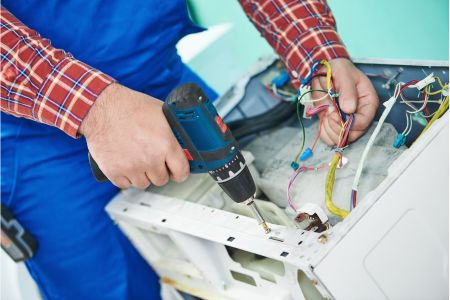
In the modern home, a washing machine is as indispensable as any other appliance.
But, like all investments, a washing machine’s longevity depends significantly on how you maintain it. Whether you have a manual (semi-automatic) or an automatic washing machine, each comes with its own set of maintenance needs.
Let’s dive deeper into how to care for these machines and understand their typical lifespans.
1. Caring for Manual (Semi-Automatic) Washing Machines
- Regular Cleaning: With separate tubs for washing and spinning, it’s essential to clean both regularly. Leaving them damp can lead to mold growth. Wipe them down with a dry cloth after every use.
- Lint and Residue: Manual machines may not have advanced lint filters. Make it a habit to check for lint and detergent residues, ensuring they don’t build up over time.
- Water Drainage: Ensure the drainage hose is not kinked or blocked. After draining the water, it’s good practice to leave the hose end elevated to prevent any backflow.
- Moving Parts: The agitator, commonly found in manual machines, can wear out. Check it for signs of wear and tear and consider replacing if needed.
- Avoid Overloading: While it’s tempting to wash more clothes at once, overloading can strain the machine’s motor. Stick to recommended load sizes.
2. Caring for Automatic Washing Machines
- Door Gasket: Especially in front-loading automatic machines, the gasket (rubber seal) can trap moisture, leading to mold. Wipe it down and leave the door slightly ajar between washes.
- Detergent Tray: Residue can build up here. Regularly remove the tray, rinse it out, and let it air dry.
- Cleaning Cycles: Many automatic machines come with self-cleaning or tub cleaning cycles. Running this once a month helps prevent detergent build-up and unpleasant odors.
- Leveling: An unbalanced machine can vibrate excessively, leading to premature wear. Ensure your machine is level using its adjustable feet.
- Lint Filters and Drain Pumps: Check these regularly for obstructions. Items like coins or hairpins can sometimes find their way here.
- Quality Detergents: Use the recommended type and amount of detergent. Excess detergent can result in build-up inside the machine.
3. Lifespan of Washing Machines
The longevity of a washing machine depends not only on its maintenance but also on its build quality, usage frequency, and brand reputation.
- Manual Machines: With fewer electronic components and simpler mechanisms, manual machines are often considered more durable in the long run. With proper care, they can last anywhere from 10 to 15 years. However, parts like the agitator might require replacement over time.
- Automatic Machines: These are a bit more complex. With electronic components and intricate mechanisms, there’s more that can go wrong. Typically, with diligent maintenance, they can last 7 to 12 years. Front-loaders might have issues like gasket replacements, while top-loaders might face drum balance issues.
Both manual and automatic washing machines are built to last, but their longevity is closely tied to how they’re cared for.
Regular maintenance, following user guidelines, and addressing small issues before they escalate can ensure that your machine serves you efficiently for years to come.
Impact on Fabric Quality: Understanding the Dance Between Fabrics and Machines
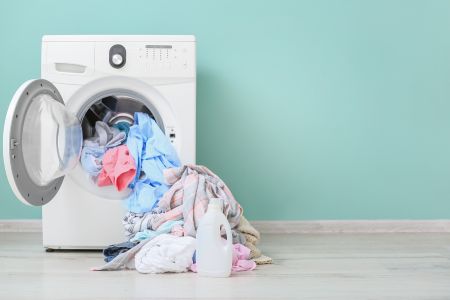
The fabric of our clothes speaks volumes about us. From the delicate laces to the rugged denims, each has its story and care requirements.
When selecting a washing machine or choosing a wash cycle, it’s imperative to understand its impact on different fabrics.
Let’s delve into the intricate world of textiles and how both manual and automatic washing machines interact with them.
1. Common Types of Fabric
a. Cotton: A widely-used fabric, cotton is known for its softness and breathability.
- Care and Maintenance: While cotton is fairly durable, it can shrink when exposed to high temperatures. It’s best washed in cold to warm water. Heavy cotton items like jeans might require a more robust wash cycle, while lighter cotton garments prefer a gentler approach.
b. Wool: This natural fiber is beloved for its warmth.
- Care and Maintenance: Wool is prone to shrinkage and felting. Always use cold water and a gentle cycle. It’s usually recommended to hand wash or use the wool-specific setting if your machine has one.
c. Silk: This luxurious fabric is known for its smooth texture and shimmering appearance.
- Care and Maintenance: Silk is delicate and can be damaged by regular detergents and vigorous washing. Always opt for a gentle cycle, use detergents meant for delicate fabrics, or hand wash.
d. Polyester and Other Synthetics: Common in activewear and many modern garments.
- Care and Maintenance: Polyester is durable and doesn’t shrink like natural fibers. It can be washed in warm water. However, avoid high temperatures as it can cause the fabric to melt or deform.
e. Linen: Made from the flax plant, linen is known for its durability and coolness in hot weather.
- Care and Maintenance: Linen can withstand higher temperatures, but it’s best washed in cool to warm water to avoid shrinkage. While it wrinkles easily, the wrinkles often add to its charm.
2. Which is Gentler on Clothes?
Manual (Semi-Automatic) Machines: These machines often use an agitator or impeller for washing. This can be robust and may cause wear and tear over time, especially on delicate fabrics. However, the flexibility of pausing and controlling the wash can be an advantage.
Automatic Machines: They use a tumbling action, especially front-loaders, which is typically gentler than the agitator method. Modern machines also come with multiple settings for different fabrics, ensuring they receive appropriate care.
3. Delicate Fabrics: Manual or Automatic?
Delicate Fabrics in Manual Machines: While it’s possible to wash delicate fabrics in manual machines, extra care is needed. Avoid overloading, and try to minimize the time they spend in the machine. You also have the flexibility to intervene and ensure they aren’t twisted or stretched.
Delicate Fabrics in Automatic Machines: Most modern automatic machines offer settings specifically designed for delicates. This ensures a gentle wash with minimal agitation. Front-loading machines, with their tumbling action, are especially suitable for fragile textiles.
The choice between manual and automatic largely depends on the type of fabrics you frequently wash and your involvement in the washing process.
While automatic machines provide tailored settings for various fabrics, manual machines offer greater control over the wash process.
Understanding your fabrics and their care requirements will ensure they remain in top-notch condition, no matter which machine you choose.
Safety and Precautions in Washing Machines: A Comparative Analysis
The safety of your washing machine isn’t merely about avoiding electrical faults or water leaks. It also encompasses ensuring that your clothes remain undamaged and that the machine serves its full life without frequent breakdowns. Below, we’ll discuss the safety aspects, benefits, and precautions to consider for both manual and automatic washing machines.
Manual (Semi-Automatic) Washing Machines:
Benefits:
- User Control: You’re in charge! The user can decide when to switch between wash and spin cycles.
- No Continuous Water Supply Needed: Water is added manually, making it suitable for places with intermittent water supply.
- Cost-effective: Generally cheaper to purchase than automatic machines.
Common Issues & Precautions:
- Overloading: Overfilling can strain the motor and reduce wash efficiency.
- Precaution: Stick to the manufacturer’s recommended load size.
- Excessive Detergent: Using too much detergent can leave residues.
- Precaution: Measure detergent according to the load size and wash cycle.
- Water Draining Issues: Drainage might not be as efficient as in automatic machines.
- Precaution: Ensure the drainage hose isn’t kinked and is placed correctly.
Safety Features to Consider:
- Sturdy Lid: A robust, lockable lid prevents water splashing and accidental opening during operation.
- Non-slip Feet: This ensures the machine remains stable during the spin cycle.
Automatic Washing Machines:
Benefits:
- Ease of Use: Just load the laundry, add detergent, set the program, and the machine does the rest.
- Varied Wash Programs: From heavy-duty to delicate, there’s a program for every type of fabric.
- Water Efficiency: Most modern automatic machines adjust water levels based on the load.
Common Issues & Precautions:
- Locked Doors: Front-loaders especially can become problematic if the door lock system fails.
- Precaution: Wait a few minutes after the cycle ends for the safety lock to release. Don’t force it open.
- Mold and Mildew: Moisture accumulation can lead to mold, especially in front-loaders.
- Precaution: Leave the door ajar after washing to allow the drum to dry.
- Imbalance Issues: Automatic machines can become noisy and move if the load is unbalanced.
- Precaution: Distribute laundry evenly and use the correct cycle for the type and weight of the load.
Safety Features to Consider:
- Child Lock: Essential for households with curious kids, it prevents them from changing settings or opening the machine during operation.
- Overflow Protection: Detects potential overfills and prevents flooding.
- Thermal Protection: In case of motor overheating, this feature shuts down the machine to prevent potential fires.
- Auto Shut-off: Turns off the machine after a cycle is completed, saving energy and enhancing safety.
Both manual and automatic washing machines come with their benefits and challenges.
Manual machines offer cost-effectiveness and user control but require more hands-on intervention.
Automatic machines, on the other hand, offer convenience and varied settings but may have concerns like mold growth if not properly maintained.
Safety, in both cases, revolves around using the machine as per the manufacturer’s guidelines, being aware of its features and limitations, and promptly addressing any issues that arise.
Always prioritize features that enhance safety and efficiency when purchasing a new machine.
In Summary: The Modern Marvel of Laundry
The evolution of the washing machine, from its rudimentary beginnings to its current sophisticated designs, has reshaped our approach to laundry.
Whether you lean towards the hands-on approach of manual machines or the hassle-free experience of automatic ones, there’s no denying the vast strides made in this domain.
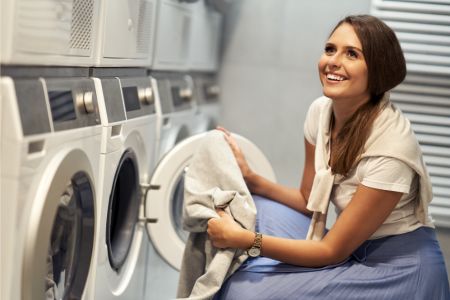
Key Takeaways:
- Evolution Over Time: Our laundry practices have shifted dramatically. From scrubbing on rocks and using washboards, we now have machines that can cater to specific fabric types and offer settings ranging from heavy-duty washing to delicate spins.
- Versatility in Choices: Both manual and automatic washing machines serve purposes. While automatic machines offer unmatched convenience, manual ones can be a boon for fabrics needing a gentle touch or places with power limitations.
- Economic & Ecological Footprints: The initial cost of an automatic washing machine is outweighed by long-term benefits like reduced water consumption, energy efficiency, and prolonged fabric life.
- A Focus on Fabric: Different fabrics require varied care. Modern machines consider this by providing options suitable for everything, from rugged jeans to fragile silks.
- Safety & Precautions: Like all appliances, washing machines come with their sets of precautions. Features like delayed start, water level options, and consistent washing cycles not only enhance user experience but ensure safety.
- A Lifesaver in Daily Routines: Amidst busy lives, the automatic washing machine emerges as a hero, saving time and reducing daily stress, proving it’s not just an appliance but a household ally.
The narrative of the washing machine is intertwined with the story of human progress and innovation. As technology surges forward, so does our desire for efficiency and ease, and in this journey, the humble washing machine stands as a symbol of both.